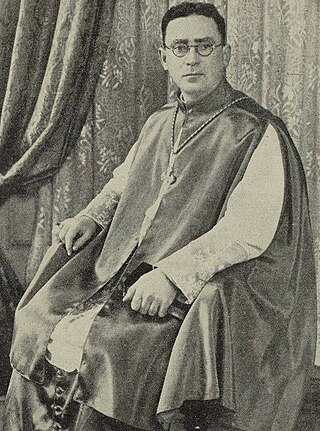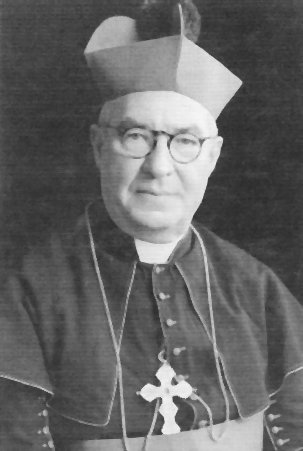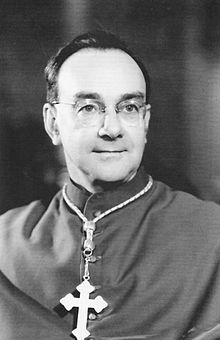
The Australian Catholic Church or Catholic Church in Australia is part of the worldwide Catholic Church under the spiritual and administrative leadership of the Holy See. From origins as a suppressed, mainly Irish minority in early colonial times, the church has grown to be the largest Christian denomination in Australia, with a culturally diverse membership of around 5,075,907 people, representing about 20% of the overall population of Australia according to the 2021 ABS Census data.

Daniel Patrick Mannix was an Irish-born Australian Catholic bishop. Mannix was the Archbishop of Melbourne for 46 years and one of the most influential public figures in 20th-century Australia.

Sir Norman Thomas Gilroy was an Australian bishop. He was the first Australian-born cardinal of the Roman Catholic Church.

The Roman Catholic Archdiocese of Melbourne is a Latin Rite metropolitan archdiocese in Melbourne, Victoria, Australia. Erected initially in 1847 as the Diocese of Melbourne, a suffragan diocese of Archdiocese of Sydney, the diocese was elevated in 1874 as an archdiocese of the Ecclesiastical Province of Melbourne and is the metropolitan for the suffragan dioceses of Sale, Sandhurst, Ballarat, and the Ukrainian Catholic Eparchy of Ss Peter and Paul. The Archdiocese of Hobart is attached to the archdiocese for administrative purposes. St Patrick's Cathedral is the seat of the Archbishop of Melbourne, currently Peter Comensoli, who succeeded Denis Hart on 1 August 2018.

Sir Thomas Francis Little KBE was an Australian bishop. He was the sixth Roman Catholic Archbishop of Melbourne. He was appointed by Pope Paul VI on 1 July 1974 and retired in 1996; he was succeeded by the Most Reverend George Pell. On retirement he was styled Archbishop Emeritus in the Archdiocese of Melbourne. The Royal Commission into Institutional Responses to Child Sexual Abuse found that Little had led a culture of secrecy in the Melbourne archdiocese designed to hide complaints against several priests and protect the church's reputation from scandal.

Sir James Duhig KCMG was an Irish-born Australian Roman Catholic religious leader. He was the Archbishop of Brisbane for 48 years from 1917 until his death in 1965. At the time of his death he was the longest-serving bishop in the Catholic Church (1905–1965).

The Roman Catholic Archdiocese of Adelaide is a Latin Church metropolitan archdiocese of the Catholic Church in Australia located in Adelaide, South Australia.

The Archdiocese of Sydney is a Latin Church ecclesiastical territory or archdiocese of the Catholic Church. Its episcopal see is Sydney, New South Wales, Australia.

James Robert Knox GCC was an Australian prelate of the Catholic Church. After years as a Vatican diplomat, he served as Archbishop of Melbourne from 1967 to 1974, prefect of the Congregation for Divine Worship and the Discipline of the Sacraments from 1974 to 1981, and president of the Pontifical Council for the Family from 1981 until his death in 1983. Created a cardinal in 1973, he was the first Australian to serve in the Roman Curia.

Patrick Joseph Clune CSsR, an Australian metropolitan bishop, was the fourth Roman Catholic Bishop of Perth and first Archbishop of Perth. Clune served continuously in these roles from 1910 to 1935.

Patrick Lyons was an Australian prelate of the Catholic Church. He was the third Bishop of Christchurch, New Zealand (1944–1950), Auxiliary Bishop of Sydney, New South Wales, Australia (1950–1957) and fourth Bishop of Sale, Victoria, Australia (1957–1967).
James William Gleeson was an Australian clergyman and the sixth Catholic Archbishop of Adelaide. He was the first South Australian priest to become Catholic Archbishop of Adelaide.

Andrew Killian was an Irish clergyman and the fourth Archbishop of Adelaide. Born and ordained in Ireland, Killian moved to Australia, where he became Bishop of Port Augusta before succeeding Robert Spence as Archbishop of Adelaide.

Robert William Spence was an Australian Roman Catholic clergyman, and the third Roman Catholic Archbishop of Adelaide. Born in Ireland, Spence became a Dominican priest, and after serving as a prior in Kilkenny, moved to Adelaide, Australia in 1898. In 1915, he became Archbishop of Adelaide, a position he held until his death in 1934.

John O'Reily was an Australian Roman Catholic clergyman, the first Bishop of Port Augusta, and the second Archbishop of Adelaide. Born in Kilkenny, Ireland, O'Reily studied for the priesthood in Dublin. Upon his ordination in 1869, he migrated to Western Australia, serving as a parish priest in Fremantle, and founding a Catholic newspaper there. When the Diocese of Port Augusta was established in 1887, Pope Leo XIII named O'Reily as its first bishop. Concerned about the financial position of the diocese, he accepted the posting reluctantly. As bishop, he greatly improved the financial position of the new diocese, reducing its debt by half and earning a reputation as a competent administrator.
Michael O'Farrell, an Australian suffragan bishop, was the fourth Bishop of the Roman Catholic Diocese of Bathurst, New South Wales. O'Farrell was consecrated by the Apostolic Delegate, Archbishop Cattaneo in 1920 and served until his death in 1928. O'Farrell was the first Vincentian bishop in Australia.

The Southern Cross is the official publication of the Catholic Archdiocese of Adelaide. About 5000 copies are printed monthly and distributed to parishes, schools and agencies, besides an online version. It began in July 1889 as a weekly magazine published in Adelaide, South Australia, for the Catholic Archdiocese of Adelaide, and remained a weekly for most of its history. Its banner was subtitled A weekly record of Catholic, Irish and General Intelligence, and later Organ of the Catholic Church in South Australia. The current, non-print website version of the magazine also bears the name Southern Cross.

St Joseph's Technical School, Abbotsford traces its beginnings to the opening of St. Joseph's Primary School on the same site in 1893 and was operated in the tradition of the Christian Brothers as a school for boys. In 1930 its function changed to that of a technical school. The school was formally closed in 1990.
Josephine Dene Laffin is an Australian historian and a senior lecturer at Australian Catholic University. She is known for her research on Australian saints and clergymen, particularly Matthew Beovich.
Aquinas College on Montefiore Hill, at Palmer Place, North Adelaide, is a residential college providing accommodation and support for Roman Catholic students at one or other of Adelaide's universities: University of Adelaide, Flinders University and the University of South Australia. The centrepiece of the establishment is "Montefiore", once the residence of Sir Samuel Way and (later) his family.


















